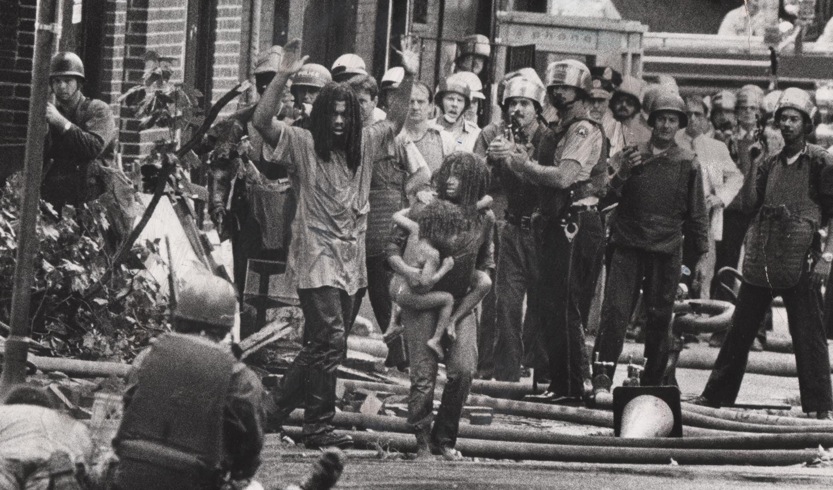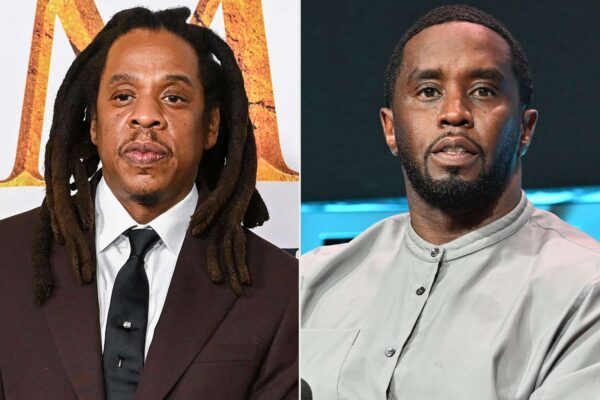[Speaking Truth To Power]
This week marks the 30 year memorial of the multiple murder of members of MOVE perpetrated by members of the Philadelphia Police Department—with the blessings of city leaders like then Mayor Wilson Goode.
This year’s MOVE memorial is important in light of the rampant police abuse and killings of African-Americans nationwide. What should we have learned from the vicious attacks on MOVE and how does it connect to current police brutality and murder in America?
The May 13, 1985 bombing of MOVE, and that it was acceptable to many, was a shocking moment underscoring the depth of institutional racism that operates within police departments and among government officials who underwrite police practices and procedures in Black communities.
On that fateful day, the Philadelphia Police used C-4 explosives and bombed, by helicopter, the building on 62nd and Osage Avenue belonging to MOVE, killing 11 people—including five children—destroying over 60 homes, and leaving over 250 people homeless in this area of West Philadelphia.
The target of the attack were members of the Black self-reliance movement named MOVE—who, because of their non-“traditional” communal lifestyle, independence, and their forceful resistance of police brutality, came under intense scrutiny.
MOVE was founded by Korean war veteran John Africa, also known as Vincent Leaphart, in 1972. The group fostered a love for their African roots and all members adopted “Africa” as their last name, in some ways reminiscence of Malcolm X and other Black Muslims adopting “X” as their last name to highlight the fact that enslaved Africans had been stripped of their language, names, culture, spirituality and essence.
MOVE’s back-to-nature type of lifestyle was looked upon as too radical and even some African-Americans viewed them as a strange and problematic group—and reportedly, “quality-of-life” complaints were made against them by neighbors.
These complaints gave then-Mayor Phil Rizzo an excuse to launch an earlier offensive on the group on August, 8, 1978—through a court order to remove MOVE from their then communal residence in Powell Village.
By 1978, after what MOVE says were repeated unwarranted assaults by police, the group adopted a more radical stance, with respect to their right to defend themselves from attacks. During the attempt to force MOVE out of their home, a shootout ensued where Officer James Ramp was killed, allegedly, by MOVE—although, MOVE points out Officer Ramp was shot in the back of the head, in a manner making it plausible that he was really shot by his fellow officers.
The death of Officer Ramp further escalated the long clash MOVE had with Philadelphia Police and their formerly caustic commissioner Rizzo, who was the city’s mayor by 1978. Under Rizzo, Philadelphia Police had a reputation of being one of the more brutal police department in the country, the brutality being largely aimed at African-Americans.
Rizzo’s thuggish behavior, and apparent racist mindset, appears to have been thoroughly embedded in the culture of the Philadelphia Police. “Law and order” here meant people with badges and blue uniform were allowed to brutalize suspects—and anyone who was Black they felt like attacking. Rizzo, as private citizen, was videotaped several times attacking journalists who dared ask him strong questions, and even challenged one reporter to a fight, on tape.
The fact that a supposed official of “law and order,” who was a police officer, police commissioner and mayor, acted worse than a mafia goon is insightful as we consider the current question with respect to the excess of cases we have witnessed where the police were the ones disturbing the peace.
Widespread police brutality against Blacks is not new, but, the video technology of today and social media have exposed the ugliness and scope of police oppression.
The use of this technology by citizens is starting to act as a check on officer’s interactions with Black people. It’s also forcing the rest of America to see what many people must have known about, but avoided talking about, through plausible deniability.
Now that the whole world saw how unarmed Eric Garner was basically lynched by NYPD officer Daniel Pantaleo who used his right arm like a noose, and how Walter Scott was shot by Michael Slager in North Charleston, and how a limp Freddie Gray was taken into custody in Baltimore by police and ended up dead with a severed spine; it’s hard for people to continue pretending ignorance.
We must push for body-cams and videos equipment to be installed on all police vehicles and inside every police precinct across America. In fact, police should be required to be able to produce a full video account—upon request—of any and every interaction, arrest, booking, and so forth.
Yet, even if these goals are achieved there must be a push for even deeper restructuring of police departments.
Why are police forces of predominantly White officers who don’t even live in the communities are have any familiarity allowed to police African-American neighborhoods — places where some of these officers view as war zones and the inhabitants as “enemy combatants”? The reverse, where predominantly Black officers on a police forces operating in White areas would never be allowed.
We must stop pretending we live in a color blind society; for as long as that remains aspirational, we must deal with the realities and tragedies confronting us today.
The attacks that occurred against the MOVE organization was a continuation of the vicious attacks that law enforcement agencies like Counter-Intelligence Programs (COINTELPRO) the FBI launched against Black self-reliance groups like the Black Panther Party. Let’s not forget, fighting police brutality was a primary concern of most of those groups. The local police, and the FBI no doubt, found it unacceptable when the Panthers started to police the police in Black areas where police brutality and murder was an everyday reality.
The same way “law enforcement” agencies and personalities like J. Edgar Hoover carried out political assassination against Black self-reliance fighters like the charismatic Fred Hampton — killed while he was sleeping– should make it clear to us they will also kill regular Black people.
Such police departments—with their ingrained institutional racist policies— cannot “protect and serve” in African-American neighborhoods until these realities are dealt with. As a bare minimum, police officers, White or African-American, must be required to live within the town, borough, or city they patrol.
Just before the Freddie Gray killing we witnessed the cold blooded killing of Walter Scott. His killer Walter Scott shot him down as was running away. If Fedin Santana wasn’t brave enough, and aware enough, to videotape Officer Slager, wouldn’t this murderous man still be on the force today? Wouldn’t police officials be insisting he didn’t do anything wrong and that he had followed proper police “procedures”?
Police union representatives in Baltimore are now demanding a special prosecutor be appointed and that State Attorney Marilyn Mosby should be removed for supposed conflict of interest grounds, including claims that because her husband is a city councilman and that she lacks objectivity. In both the Michael Brown and Eric Garner cases, prosecutors Bob McCulluch and Daniel Donovan, respectively, both had extensive ties to the police. No police union official complained about any conflicts of interest in those cases.
The only conflict here is: cops never expect to pay any price no matter what horrendous crime they inflict on African-Americans. During segregation, many White men considered it a rite of passage to lynch Blacks. Cases against cops who kill Blacks are usually rigged to exonerate cops. Ironically, or maybe expectedly, cops are now the people who engage in violent victimization of African-Americans—and their badge gives them this “license to kill”.
Interestingly, this prosecutor Mosby, by conducting her own parallel investigation, has done something not often done by prosecutors in cases where police have been charged with killing some Black person. Usually, the very prosecutors who are supposed to be prosecuting some officer is usually depending on the evidence being given to them by members of the same police department.
All these recent wrongful killings of African-Americans take us back to the assault against MOVE 30 years ago.
The bombing of MOVE in 1985 represented one of the most extreme attacks American law enforcement has ever taken against a group of Black people.
However, it should be understood within the context of the long fight against police brutality and institutional racism within this country’s criminal justice system that continues today in cases like Freddie Gray killing in Baltimore.
Editor’s Note: MOVE had a 30th anniversary commemoration event on May 13, 2015. The following message is from Ramona Africa: “ONA MOVE, everybody. A great big warm hug and thanks to all of you who were able to join us on May 13th and make it the success that it was. We also understand that a lot of you wanted to be with us but couldn’t. I’m sending this email to inform you that we will have available, within a week, no longer than 2, the 4 hour dvd of the program with all the speakers. The dvd will be $15.00 plus $3.00 postage. We will add it to our web site so you can order it that way but for those of you who don’t deal with computers or paypal you can mail your order to me. Make checks or money orders out to “MOVE” and mail your order to me, Ramona Africa, at 4506 Kingsessing Ave. Phila., PA. 19143. Thanks for all your continuing support. STAY STRONG, FIGHT BACK!——Ramona”







